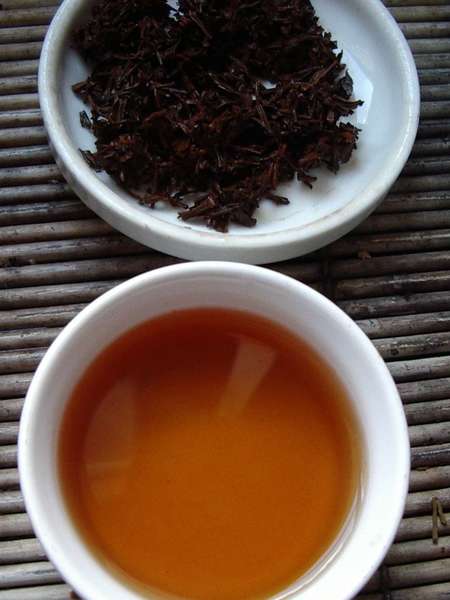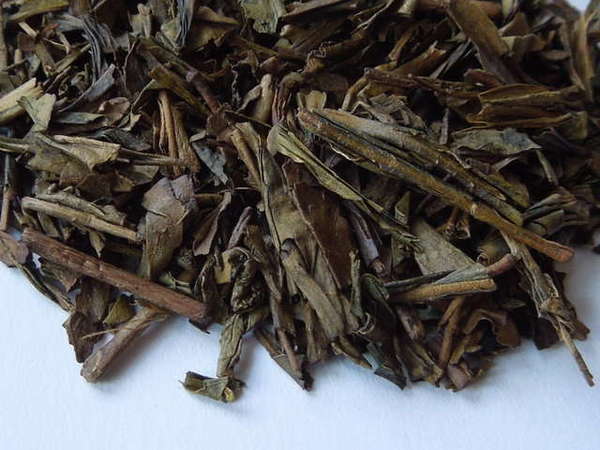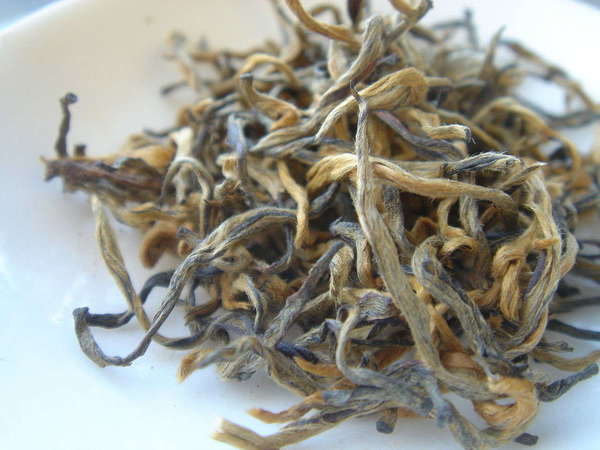Tannins in Tea
Wikipedia: TanninLast Updated: Jul. 23, 2015
 Tannins are responsible for the dark color of black tea. Photo by Labrau, licensed under CC BY-SA 3.0.
Tannins are responsible for the dark color of black tea. Photo by Labrau, licensed under CC BY-SA 3.0.Tannins are naturally occurring and common, and are an important component of red wine. They are also responsible for the dark color in some streams, as they are found in leaves and wood, and are released as organic matter breaks down.
The name "tannin" originated in the historical use of these compounds in tanning animal hides to make leather.
Tasting and seeing tannins
People talk of some teas having a "tannic quality", which usually describes the pairing of a sharp bitterness with a strong astringency in black teas with a dark color. This bitterness contrasts with the bitterness imparted by caffeine, which need not be paired with astringency, and can occur in teas with a very light color.Less oxidized teas, like green tea, can be highly astringent and bitter even while being light in color. This is in large part because they contain other chemicals, such as catechins, which share certain similarities with tannins, but lack the dark color.
Myths about tannins and health
There are numerous misconceptions in popular media about the tannins in tea. Some of the most widespread of these myths are:- Tea contains tannic acid - False. Tea does not contain any tannic acid. This myth stems from confusion between tannins (a broad class of compounds) and tannic acid, a specific type of tannin. Tea contains tannins other than tannic acid.
- Tannins are bad for you. - False. As explained below, tannins have both positive and negative effects on health, and like most substances, are healthiest in moderation.
- Tannins taste bad or make a tea low quality - False. Too high a concentration of tannins in a cup of tea can result in an unpleasantly astringent cup, but tannins also impart a sensation of body and strength to a tea, and make for a richer mouthfeel: a black tea with too few tannins would be more likely to seem watery, weak, or thin-bodied.
 Just like in tea, tannins can also color the waters of some rivers and streams, producing the rich reddish hue shown here. Public domain photo by Pseudopanax.
Just like in tea, tannins can also color the waters of some rivers and streams, producing the rich reddish hue shown here. Public domain photo by Pseudopanax.James Norwood Pratt in his Tea Dictionary goes even farther, claiming that the term "tannins" is an obsolete term for the polyphenols in tea. He notes that the term was adopted in the 1800's, when the distinction between the polyphenols and tea and the tannic acids in oak were not well-understood.[1] However, the term tannin is widely used and is an accepted scientific term; although the association between tannic acid and tea has long been viewed as a misconception[2], the broader class of compounds, including the polyphenols in black tea, are commonly described as tannins, even in the contemporary scientific literature.
What types of tannins are found in tea?
The tannins found in tea are called thearubigins, a class of chemicals which includes theaflavins. These chemicals are formed in black tea when the antioxidants inherent in green tea, called catechins, become oxidized. Tea does not contain any tannic acid.[2]The tannins in tea are thus responsible for the antioxidant activities of black tea and many other dark (oxidized) teas, including more-oxidized oolong teas. However, these same chemicals can also have negative impacts on health; the tannins are also responsible for tea's inhibiting effect on iron absorption.[3]
 The dark color of this hojicha is due not to tannins, but to roasting, which produces another class of compounds imparting a dark color to both the leaf and the brewed cup.
The dark color of this hojicha is due not to tannins, but to roasting, which produces another class of compounds imparting a dark color to both the leaf and the brewed cup.Not all dark-colored substances in tea are tannins
Many teas, including some oolongs, or Japanese hojicha, are roasted, giving them a dark color which superficially resembles black tea. These other substances have a distinct flavor and mouthfeel--as is evidenced by the much smoother flavor and lower astringency of hojicha and some roasted oolongs, relative to black teas that are similarly dark. Oolongs that are both oxidized and roasted can have a dark color from a combination of tannins and various other compounds formed by the roasting.
Nutritional and health effects of tannins
Tannins are a diverse class of compounds, and have diverse effects on health. Tannins are often considered antinutritional, as animal studies suggest they can reduce net metabolizable energy and protein digestibility. However, these same compounds often exhibit anti-carcinogenic and anti-mutagenic properties, probably due to their antioxidant activity. Tannins also have well-documented antimicrobial properties, effective against many bacteria, fungi, and viruses.[4]Many specific compounds within the class of tannins have other biological activity or medical uses, which include speeding of blood clotting, reduction of blood pressure, and effects on the liver and immune system.[4]
Low tannin teas (especially black teas)
 Golden Yunnan teas, like this tippy spring harvest tea, are relatively lower in tannins. Photo © Sjschen (Wikimedia Commons), CC BY 3.0.
Golden Yunnan teas, like this tippy spring harvest tea, are relatively lower in tannins. Photo © Sjschen (Wikimedia Commons), CC BY 3.0.- Darjeeling first flush - Some Darjeeling first flush teas are unusually light in character; this is due in large part to the thin, dry air that exists in the early spring at high altitudes. First flush Darjeeling teas are harvested from the new growth that follows just after the first spring rains, so the air is still thinner and drier. This makes the leaf dry out faster during processing, so it does not oxidize fully, thus retaining similar characteristics to green teas or greener oolongs.
- Gold teas, including Yunnan pure gold and golden monkey - Some high-grade black teas are made mostly or exclusively from golden tip. These teas can have a very light color to the dry leaf, and, although they produce a dark-colored infusion when brewed, are often markedly lower in tannins than their lower-grade counterparts. Be careful though, as many teas labelled as "Yunnan Gold" or "gold tip" teas still contain a lot of larger, more mature leaves, and can still be quite tannic.
High tannin teas
In general, teas rich in tannins tend to be easier to obtain, and tend to be less expensive, than low-tannin teas. Low-qualilty black teas, such as the fannings or dust in most tea bags, are usually high in tannins, and as a general rule, lower grades of tea tend to have more tannins than higher grades. However, grade does not always correspond to quality, and there are high-quality teas and artisan teas that are rich in tannins as well.Assam black tea is the most widespread single-origin black tea that tends to be high in tannins. Other styles of tea with similar qualities include English Breakfast and Irish Breakfast.
References
1. James Norwood Pratt, Tea Dictionary, 2010, pp. 263.
2. Stephen R. Wheeler, Tea and Tannins, Science, Letters, Vol. 204, No. 4388, pp. 6-8 , April 1979.
3. Effect of tea and other dietary factors on iron absorption., Critical Reviews in Food Science and Nutrition, Sep. 2000, Vol. 40, No. 5, pp. 371-98.
4. Chung KT, Wong TY, Wei CI, Huang YW, Lin Y., Tannins and Human Health: A Review, Critical Reviews in Food Science and Nutrition, Vol. 38, No. 6, pp. 421-64, Aug. 1998.

